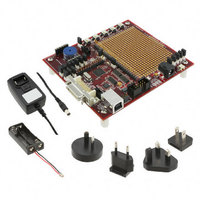EM260-BBRD-128K-USART-R Ember, EM260-BBRD-128K-USART-R Datasheet - Page 18

EM260-BBRD-128K-USART-R
Manufacturer Part Number
EM260-BBRD-128K-USART-R
Description
EM260 BREAKOUT BOARD
Manufacturer
Ember
Type
Transceiver, 802.15.4/ZigBeer
Datasheet
1.EM260-RCM-USART-R.pdf
(54 pages)
Specifications of EM260-BBRD-128K-USART-R
Frequency
2.4GHz
For Use With/related Products
EM260
Lead Free Status / RoHS Status
Lead free / RoHS Compliant
Other names
636-1026
4.7
4.8
4.9
4.10 Power-on-Reset (POR)
120-0260-000J
Encryption Accelerator
nRESET Signal
Reset Detection
operations, consider an EM260 in a stable network (no joins or leaves) not sending any messages and the Host
is using only one of the 8-byte tokens available to it. Under this scenario, a very rough estimate results in
approximately 330,000 possible set-token operations. The number of possible set-token calls, though, depends
on which tokens are being set, so the ratios of set-token calls for each token play a large factor. A very rough
estimate for the total number of times an App token can bet set is approximately 320,000.
These estimates would typically increase if the EM260 is kept closer to room temperature, since the 1,000
guaranteed write cycles of the Flash is for across temperature.
4.6.2
The EM260 also includes a separate 1024-byte FIA that can be used for storage of data during manufacturing,
including serial numbers and calibration values. Programming of this special Flash page can only be enabled
using the SIF interface to prevent accidental corruption or erasure. The EmberZNet stack reserves a small
portion of this space for its own use and in addition makes eight manufacturing tokens available to the
application. See EZSP Reference Guide (120-3009-000) for more information.
The EM260 contains a hardware AES encryption engine that is attached to the CPU using a memory-mapped
interface. The CBC-MAC and CTR modes are implemented in hardware, and CCM* is implemented in software.
The first two modes are described in the
Specification
require security at the application level.
When the asynchronous external reset signal, nRESET (Pin 13), is driven low for a time greater than 200ns, the
EM260 resets to its default state. An integrated glitch filter prevents noise from causing an inadvertent reset
to occur. If the EM260 is to be placed in a noisy environment, an external LC Filter or supervisory reset circuit
is recommended to guarantee the integrity of the reset signal.
When nRESET asserts, all EM260 registers return to their reset state. In addition, the EM260 consumes 1.5mA
(typical) of current when held in RESET.
The EM260 contains multiple reset sources. The reset event is logged into the reset source register, which lets
the CPU determine the cause of the last reset. The following reset causes are detected:
•
•
•
•
•
Each voltage domain (1.8V Digital Core Supply VDD_CORE and Pads Supply VDD_PADS) has a power-on-reset
(POR) cell.
The VDD_PADS POR cell holds the always-powered high-voltage domain in reset until the following conditions
have been met:
•
•
Power-on-Reset
Watchdog
PC rollover
Software reset
Core Power Dip
The high-voltage Pads Supply VDD_PADS voltage rises above a threshold.
The internal RC clock starts and generates three clock pulses.
Flash Information Area (FIA)
(ZigBee Document 053474). The EmberZNet stack implements a security API for applications that
IEEE 802.15.4-2003
Page 18
specification. CCM* is described in the
EM260
ZigBee























